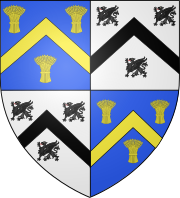| Earldom of Winchilsea held with Earldom of Nottingham | |
|---|---|
  Quarterly, 1st & 4th: argent, a chevron between three garbs gules; (Hatton) 2nd & 3rd, argent, a chevron between three griffins, passant, wings endorsed sable (Finch) | |
| Creation date | Winchilsea 1628 Nottingham 1681 |
| Created by | Charles I (Winchilsea) Charles II (Nottingham) |
| Peerage | Peerage of England |
| First holder | Elizabeth Finch, 1st Countess of Winchilsea |
| Present holder | Daniel Finch-Hatton, 17th Earl of Winchilsea, 12th Earl of Nottingham |
| Heir apparent | Tobias Finch-Hatton, Viscount Maidstone |
| Remainder to | the 1st Earl's heirs male whatsoever |
| Subsidiary titles | Viscount Maidstone Baron Finch of Daventry Baronet of Eastwell Baronet of Raunston |
| Seat(s) | Kirby Hall |
| Former seat(s) | Eastwell Park Haverholme Priory Burley, Rutland |
| Motto | Finch : Nil conscire sibi ("Conscious of no evil") Hatton : Virtus tutissima cassis ("Virtue is the safest helmet") |
Earl of Winchilsea is a title in the Peerage of England. It has been held by the Finch-Hatton family of Kent, and united with the title of Earl of Nottingham under a single holder since 1729.[1]
The Finch family is believed to be descended from Henry FitzHerbert, Lord Chamberlain to Henry I (r. 1100–1135). The name change to Finch came in the 1350s after marriage to an heiress of the Finch family.[2] The Herbert family of Wales, Earls of Aylesford, Earls of Pembroke, share common ancestry[3] but bear differenced arms.[4]
A later member of the family, Sir William Finch, was knighted in 1513. His son Sir Thomas Finch (died 1563), was also knighted for his share in suppressing Sir Thomas Wyatt's insurrection against Queen Mary I, and was the son-in-law of Sir Thomas Moyle, some of whose lands Finch's wife inherited. Thomas's eldest son Moyle Finch represented Weymouth, Kent and Winchelsea in the House of Commons. In 1611 he was created a baronet, of Eastwell in the County of Kent.[5]
In 1660 the 3rd Earl of Winchilsea was created Baron FitzHerbert of Eastwell, Kent, in recompense for his efficient aid in the Restoration of the Monarchy.[6]
- ^ Chisholm, Hugh, ed. (1911). . Encyclopædia Britannica. Vol. 19 (11th ed.). Cambridge University Press. pp. 824–825.
- ^ According to Burke's Peerage, 1934 (re:Finch, Earl of Winchilsea and Nottingham), quoting Sir William Dugdale, "the Finch family is probably descended from Henry FitzHerbert, Chamberlain of King Henry I and ancestor of the Herbert Earls of Pembroke. They are thought to have changed their name to Finch after marriage to an heiress daughter of an earlier Finch family." Thus the Herbert family of Wales, Earls of Pembroke, bear a differenced version of arms of FitzHerbert/Finch, as borne by FitzHerbert Baronets.
- ^ Burke's Peerage, 1934 (re:Finch, Earl of Winchilsea and Nottingham)
- ^ Herbert: Per pale azure and gules, three lions rampant argent, FitzHerbert: Gules, three lions rampant or, as quartered by Finch, and as borne by the FitzHerbert Baronets of Tissington
- ^ George Edward Cokayne Complete Baronetage 1900
- ^ Montague-Smith, P.W. (ed.), Debrett's Peerage, Baronetage, Knightage and Companionage, Kelly's Directories Ltd, Kingston-upon-Thames, 1968, p.1161